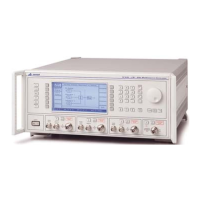GENERAL INFORMATION
46882/439 1-3
Incrementing
All major parameters can be incremented or decremented in step sizes entered via keyboard entry
or remotely. If no step size is entered for a parameter, the steps are preset to 1 kHz for carrier
frequency, 1 kHz for modulation oscillator, 1 kHz for FM deviation, 0.1% for AM depth, 0.01 rad
for ΦM and 1 dB for output level.
In addition, the rotary control knob can be used to vary the parameter with the sensitivity of the
knob being changed by means of the [×10] and [÷10] keys.
Control knob operation can be assigned for the adjustment of one parameter, while another
parameter is adjusted by the increment and decrement keys. By this means two parameters, for
example carrier frequency and RF level, can be adjusted simultaneously.
Frequency sweep
The sweep capability of the instrument allows comprehensive testing of systems. Four parameters
are used to specify sweep; start, stop, step size and time per step, all of which may be specified by
the user. The sweep can be paused at any time and the frequency and level manually altered.
During the sweep the RF level can be altered using the rotary control. Sweep triggering can be
single shot or continuous and can be initiated directly or on the detection of a trigger. The
triggering signal may either be programmed or from a TTL signal applied to the rear-panel
TRIGGER 1 input. When frequency coupling is enabled, the coupled sources will track with the
swept source.
Memory
The instrument provides both non-volatile and volatile memory for storing instrument settings.
The non-volatile memory provides 100 full instrument settings and 100 settings of carrier
frequency only. The volatile memory (RAM) also provides 100 instrument settings. Any one of
the non-volatile instrument settings can be selected as the power-up setting for the instrument.
Software protection
To prevent accidental interference with the contents of internal memories, internal data is
protected.
Programming
A GPIB interface is fitted so that all functions are controllable via the interface bus which is
designed to the IEEE Standard 488.2. The instrument can function both as talker and listener.
The instrument also has an RS-232 interface which uses the common GPIB command set to
control the instrument and also allow new software upgrades or applications to be downloaded
into the instrument.
Calibration data
All alignment data is digitally derived. Realignment can be undertaken, without removing covers,
by protected front-panel functions or via the GPIB interface.
Spectral purity
With an SSB phase noise performance of typically −121 dBc/Hz at 20 kHz offset from a 1 GHz
carrier, these instruments can be used for both in-channel and adjacent channel receiver
measurements. Harmonically-related signals and non-harmonics are typically better than −30 dBc
and −60 dBc respectively.
Calibration
This instrument has a recommended two-year calibration interval after which it should be returned
for recalibration (for addresses refer to ‘International Service Centers’ section at end of manual).

